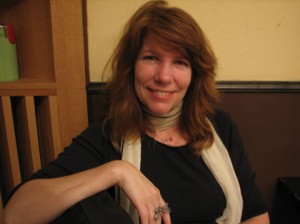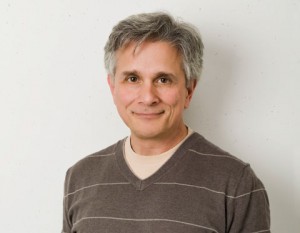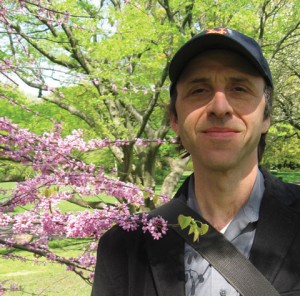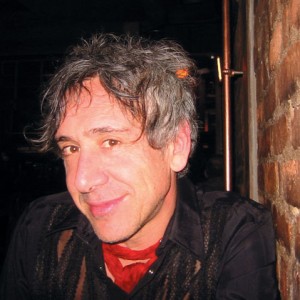A Guide to Summer Park Slope Art
“How do we get a sense of ourselves when we truly are in a network culture of speed?” asks Park Slope artist Marc Lafia. For Marc, network culture is a way to define, map, and express ourselves in new ways. For Oliver Trager and John Manno, it’s a challenge of reinvention and rediscovery. And for Marney Fuller, network culture is an opportunity to teach others how to participate in an artistic conversation. These artists explore the changing ways we communicate and define ourselves through their own lens. They are the thinkers who give the Park Slope art community its voice, whether it’s a fascination with insects, mushrooms, baseball, film theory, or an old wooden chair.

“I like to reintroduce the familiar in an unexpected way,” says Marney Fuller, a painter, sculptor, and teaching artist who is the mind behind the whimsical insect sculptures that grace the side of PS 107 on 8th Avenue and 14th Street. When her son was a student in 2008, Marney approached principal Cyntia Holton with the project as a way to get students from every grade and skill level involved in the process of making public art. “It really takes a trusting, thinking-outside-the-box principal to accept my proposal, for me to say ‘Hey, can I hang some huge insects on the side of your building? And guess what, I’ll have your kids help me do it.’” After weeks of collaborative student effort under Marney’s guidance, the spider was the first to appear on the brick building, and in April 2011 it was joined by a caterpillar and a butterfly. Not only has the project been a successful introduction to public art and installation, but it gave the students the opportunity to experience being a literal part of their artistic environment.
Marney is also the founder of the Artist Workshop Experience, a five-week summer art program she runs from her Dumbo studio. AWE accepts artists ages nine to sixteen, and Marney hires Pratt students and graduates to teach a wide selection of disciplines including painting, sculpture, graffiti, printmaking, and photography. “All the kids that come there, it’s their opportunity, they’re around people interested in art, and they’re excited about it and they think about it, and that’s what art should be about.” Aside from AWE and her paintings, Marney plans to pursue multiple public art projects this summer.

Inside Cocoa Bar on 7th Avenue, professional still-life photographer John Manno explains his preference for inanimate objects over people: “In still-life, I can make juxtapositions, form, shape, textures, light that are more visually interesting – all the things you don’t really pull out with a person,” he says. “And if even if you did, you’re still looking for more meaning behind that. All right, so you’ve got the stubble of his beard or the sparkle in the eye, but what does that mean?” He explores this idea in his ongoing series “Chair,” where he photographs the same wooden chair in snow, subway stations, beaches, stairwells – the list keeps growing. “I get odd looks,” he says with a shrug. “I traipse it through the park, and in snow, and I spend a lot of time in Red Hook,” one of his favorite spots to photograph in the city.
John has shot both editorial and commercial campaigns for companies and firms like BBDO, JWT, Digitas, Conde Nast, Michelob, and Procter & Gamble and will also teach a photography workshop at the School of Visual Arts in June. He considers himself lucky to still be a working still-life photographer at a time when online stock photos dominate most of the competition, but it’s clear through seeing his work that he enjoys the challenge. “As an artist, you’re only as good as what you’re currently working on,” he says. “You have to constantly reinvent yourself. You have to constantly come up with something new.”

On a bench in Prospect Park, writer, editor, and filmmaker Oliver Trager describes his inspirations: “My work tends to deal with the 50s. I have a love for the Beats, the Charlie Parker era, Bobby Thomson…those are subjects that speak to me, and I like to write about what I love.” Oliver is the author of three books: Keys to the Rain: The Definitive Bob Dylan Encyclopedia (Billboard Books, 2004), The American Book of the Dead (Fireside, 1997), and Dig Infinity!: The Life and Art of Lord Buckley (Welcome Rain Publishers, 2002), and he has also worked as a writer, researcher, and script consultant on several films including Tales of the Rat Fink (2006) and Know Your Mushrooms (2009). Most recently he started a blog called Painting the Word Picture, where he writes about the art and history of baseball on the radio.
“What every writer wants to do is find their voice, which is the hardest thing to do,” Oliver says. “You tell a story. You tell it to death. Then when you actually sit down to write it, you’ve already rehearsed it in some fashion.” This discipline might come from Oliver’s 24 years working as a managing editor at Facts on File, news article journal and database. He isn’t the only exceptional reference writer in the family – his father James Trager is best known for authoring the comprehensive Chronology books including The People’s Chronology, The Food Chronology, and The New York Chronology, among others. For his most recent project “All Cylinders,” Oliver has taken his father’s most recent chronology on the automobile and translated it into an online space where he plays with the possibilities of organizing a subject’s history through use of images, chronology, and text. “You can read a history book and find out all there is to know about a certain subject, but history happens in cross currents,” he says. “Things are happening in India in 1492 for instance, but we don’t really hear about that so much. So the idea is you get to really see all these things that are happening at the same time.”

This interest in non-linear history is also shared by Marc Lafia, a filmmaker and philosopher interested in network thinking and collaboration. “Power is dispersed through a number of different kinds of networks,” he says in his home on 6th Avenue during a break from editing his newest film. In addition to being the founder and architect of award-winning website Art + Culture, Marc has filmed, edited, directed, and written many films ranging from commissioned works to experimental expressions both online and in galleries like the Whitney Museum of American Art.
In his newest project Remake/Unmake, Marc shows a film to both older and younger generations of different international cities who then reenact and discuss it through their perspectives in culture and time. He has already brought Remake/Unmake to Shanghai, Ljubljana, Abu Dhabi, Rio de Janeiro, and New York and plans to expand to other cities as well. “We examine a film through what the older generation thinks is critical and promising about it as well as what energy the younger people say the film carries today and how far away it is from the promise they had. So it is a way to gather around a text, talk about it, and look at how representations change in cinema.” Marc is also working on a documentary called Empires with Park Slope neighbor and former Criterion producer Johanna Schiller where they interview political philosophers, social theorists, and network theorists in an attempt to map the global network of ideas and senses in history and “connect with people across cultures, across ideas, and find ways to be expressive and investigate the currency of ideas that gives shape to us.”
To Marc, we’re always becoming through our community, relationships, and sense of time – “the multiple vectors in which we’re living.” For all artists, exploring these vectors is the key to lending a unique perspective to the community, whether it’s a photographer who loves the rustic charm of Red Hook, a painter who also sculpts enormous arachnids and insects, a writer who can encyclopediafy any subject, or a filmmaker who takes multitasking to a new level. The difference lies in their mediums, motivations, and processes, and for these four Park Slopers, summer is only the beginning of a new idea.
